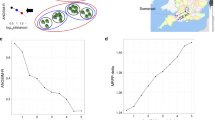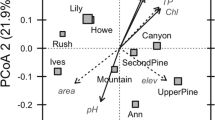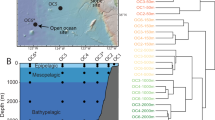Abstract
BIOLOGICAL communities usually contain few species with many individuals and many species with few individuals1. Diversity of higher organisms generally has been found to decrease with increasing population size1. Communities in physically stressed ecosystems, such as in polar regions, characteristically have low species diversity2. Diversity indices have been used to express species diversity in plant and animal communities, especially as a measure of stress on community structure2. Amongst microorganisms, diversity indices have been applied to microscopic phytoplankton populations3,4, but not to bacterial populations. Bacterial populations, however, show large variations in species diversity. For example, infections are dominated by one or a few species, whereas many bacterial species are found in an ecosystem such as soil5. We report here the application of taxonomic diversity indices to bacterial populations and a study of the relationship of the diversity indices of such populations to population size and to population-independent factors such as geographic location.
This is a preview of subscription content, access via your institution
Access options
Subscribe to this journal
Receive 51 print issues and online access
$199.00 per year
only $3.90 per issue
Buy this article
- Purchase on Springer Link
- Instant access to full article PDF
Prices may be subject to local taxes which are calculated during checkout
Similar content being viewed by others
References
Fisher, R. A., Corbet, A. S. & Williams, C. B. J. Anim. Ecol. 12, 42–58 (1943).
Odum, E. P. Fundamentals of Ecology 140, (Saunders, Philadelphia, 1971).
Hulbert, E. M. J. mar. Res. 21, 81–93 (1963).
Patrick, R., Hohn, M. H. & Wallace, J. H. Notul. natn. Acad. Philad. 259, 1–12 (1954).
Alexander, M. Microbial Ecology 10, (Wiley, New York, 1971).
Sokal, R. & Sneath, P. H. A. Principles of Numerical Taxonomy (Freeman, San Francisco, 1963).
Shannon, C. E. & Weaver, W. The Mathematical Theory of Communications (University of Illinois Press, Urbana, 1949).
Margalef, R. Perspectives in Ecological Theory (University of Chicago Press, Chicago, 1968).
Pielou, E. C. J. theoret. Biol. 13, 131–144 (1966).
Lloyd, M., Zar, J. H. & Karr, J. R. Am. Mid. Nat. 79, 257–272 (1968).
Morita, R. Bact. Rev. 39, 144–167 (1975).
Author information
Authors and Affiliations
Rights and permissions
About this article
Cite this article
KANEKO, T., ATLAS, R. & KRICHEVSKY, M. Diversity of bacterial populations in the Beaufort Sea. Nature 270, 596–599 (1977). https://doi.org/10.1038/270596a0
Received:
Accepted:
Issue Date:
DOI: https://doi.org/10.1038/270596a0
This article is cited by
-
Microbial community structure along an altitude gradient in three different localities
Folia Microbiologica (2004)
-
Soil microbial counts and identification of culturable bacteria in an extreme by arid zone
Folia Microbiologica (2004)
-
Influence of media on measurement of bacterial populations in the subsurface
Applied Biochemistry and Biotechnology (1996)
-
Effects of dispersed and adsorbed crude oil on microalgal and bacterial communities of cold seawater
Ecotoxicology (1996)
-
A new method for assessing soil microorganism diversity and evidence of vitamin deficiency in low diversity communities
Biology and Fertility of Soils (1992)
Comments
By submitting a comment you agree to abide by our Terms and Community Guidelines. If you find something abusive or that does not comply with our terms or guidelines please flag it as inappropriate.



